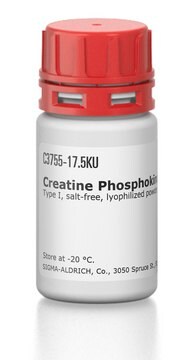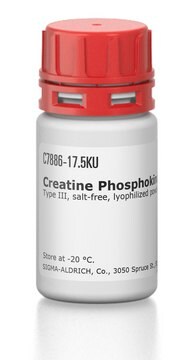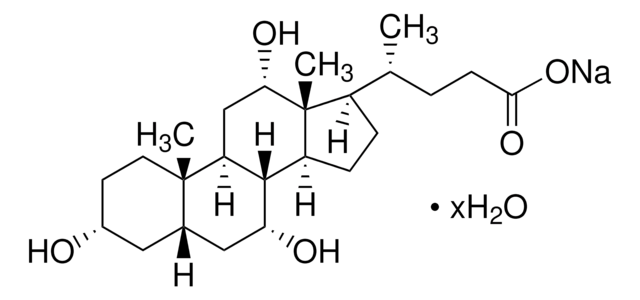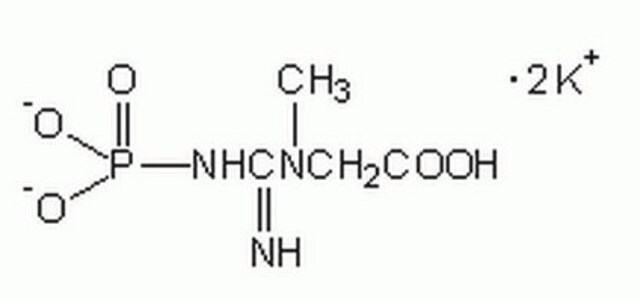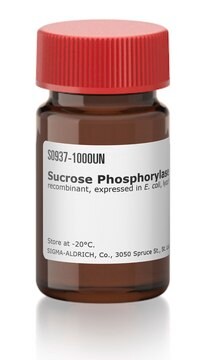CK-RO
Roche
Creatine Kinase (CK)
from rabbit muscle
Sinonimo/i:
creatine phosphokinase
About This Item
Prodotti consigliati
Origine biologica
rabbit muscle
Livello qualitativo
Forma fisica
lyophilized
Attività specifica
~350 units/mg protein (at 25 °C (800 U/mg lyophilizate at 37 °C) with creatine phosphate and ADP as the substrates, and N-acetyl-L-cysteine as the activator.)
Confezionamento
pkg of 100 mg (10127566001)
pkg of 500 mg (10736988001)
Produttore/marchio commerciale
Roche
Colore
white to light yellow
pH ottimale
6.0-7.0(reverse reaction)
9.0(forward reaction)
Solubilità
water: soluble
Compatibilità
suitable for immunoprecipitation
N° accesso NCBI
N° accesso UniProt
applicazioni
life science and biopharma
sample preparation
Attività estranea
ATPase <0.001%
HK <0.001%
myokinase <0.001%
Temperatura di conservazione
2-8°C
Informazioni sul gene
rabbit ... CKM(100009056)
Categorie correlate
Descrizione generale
Creatine kinase (CK) has a molar mass of 85kDa. It exists as a dimer in the cytosolic form and as a dimer and an octamer in the mitochondrial form. The cytosolic forms are named as MM, BB, and MB, where M and B correspond to muscle and brain, respectively. CK from rabbit muscle is a dimer containing two identical polypeptide chains of 380 amino acids. Each subunit has four cysteines, Cys73, Cys145, Cys253 and Cys282, but lacks inter- and intra-chain disulfide bonds.
Applicazioni
Azioni biochim/fisiol
Qualità
Specifiche
Definizione di unità
Stato fisico
Nota sulla preparazione
Dissolve in 0.1 M imidazole buffer; aliquot and store at -15 to -25 °C.
Stable for approximately four weeks at -15 to -25 °C.
Avoid repeated freezing and thawing.
Dissolve in 0.5% NaHCO3 solution.
Do not freeze. Store protected from light.
Stable for 2 - 3 days, when stored at 2 to 8 °C.
Or
Dissolve in 30 mM glycine buffer, pH 9.0, with 0.2 mM DTT.
Stable for 2 - 3 days, when stored at 2 to 8 °C.
Altre note
Codice della classe di stoccaggio
11 - Combustible Solids
Classe di pericolosità dell'acqua (WGK)
WGK 1
Punto d’infiammabilità (°F)
does not flash
Punto d’infiammabilità (°C)
does not flash
Certificati d'analisi (COA)
Cerca il Certificati d'analisi (COA) digitando il numero di lotto/batch corrispondente. I numeri di lotto o di batch sono stampati sull'etichetta dei prodotti dopo la parola ‘Lotto’ o ‘Batch’.
Possiedi già questo prodotto?
I documenti relativi ai prodotti acquistati recentemente sono disponibili nell’Archivio dei documenti.
I clienti hanno visto anche
Il team dei nostri ricercatori vanta grande esperienza in tutte le aree della ricerca quali Life Science, scienza dei materiali, sintesi chimica, cromatografia, discipline analitiche, ecc..
Contatta l'Assistenza Tecnica.